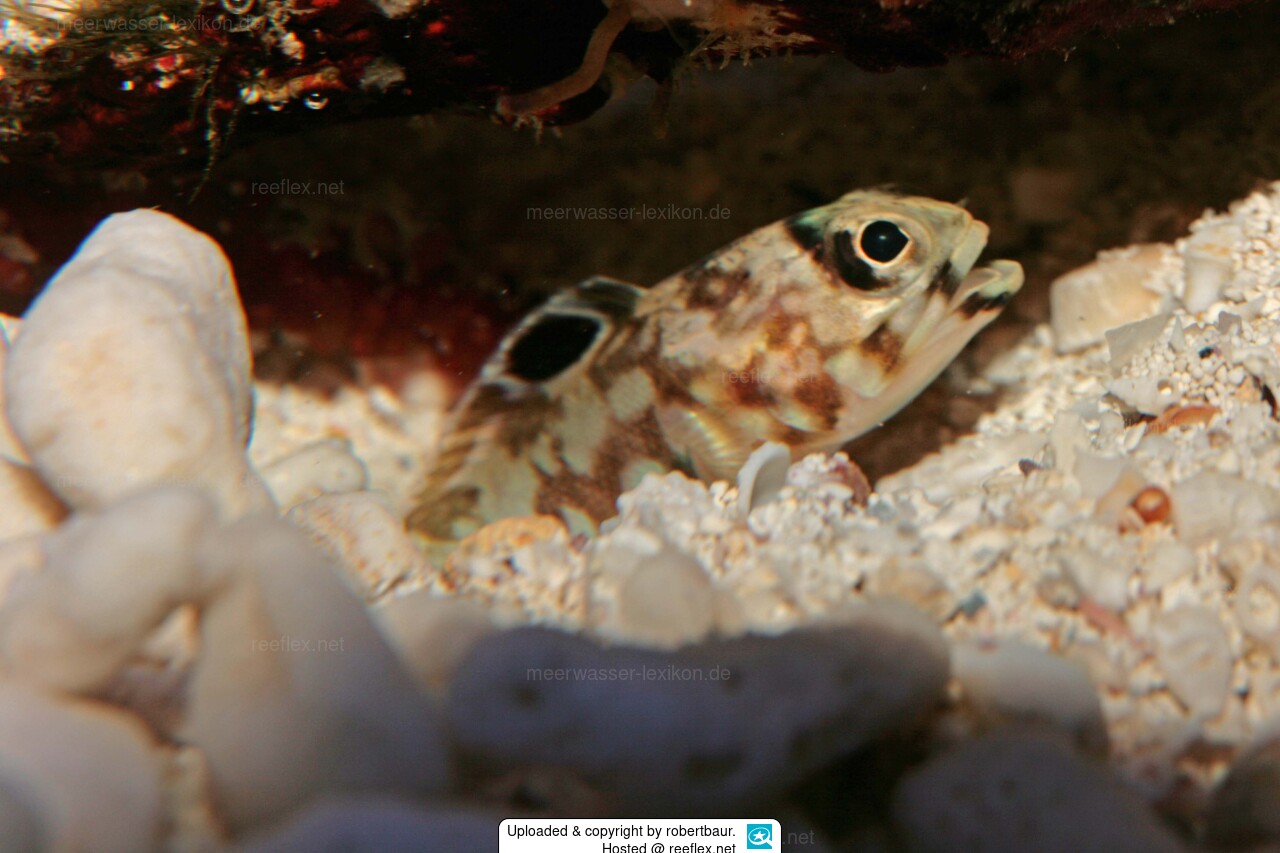Info
Opistognathus scops Jenkins & Evermann, 1889)
General information on the jawfishs:
The family of jawfishes (Opistognathidae), also known in this country as well builders, belongs to the perch family (Percomorphaceae). It consists of three genera with around 80 species. Jawfishes are found in the tropical Atlantic and Indo-Pacific, in the Gulf of California and on the Pacific coast of Central America from Mexico to Panama.
In the aquarium hobby, a variety of jawfishes are kept, some even bred very successfully, e.g. by Wolfgang Mai.
Pinefish live mainly in shallow water, mostly above 30 meters on sand and rubble. They build vertical burrows, which means that the keeper has to choose the bottom accordingly. Only fine sand hardly works well, as the inner walls of the caves are attached with the help of stones, pieces of coral, mussel shells or other materials. The substrate should also be at least 10 cm high, if not more.
Many species often live in small colonies in small territories, while some others are solitary.
The caves are usually only left at very short distances, for example to catch food or to defend their territory. Usually you can only see their head peeking out of the burrow.
All jawfishes are protogynous hermaphrodites that change sex from female to male in the course of their lives. They are permanent feeders (plankton)
About Opistognathus scops:
The pictures of Opistognathus scops (Jenkins & Evermann, 1889)) were kindly made available to us by Wolfgang Mai, the well-known fish breeder.
Needless to say, Wolfgang Mai has already had his first breeding successes.
As a result, he has bred 18 species as of 2010.
Keep them like other jawfishes, except for the following, not entirely unimportant, details:
1. never put these fish in a community tank, but specifically in a species tank where, for example, seahorses, pipefishes or other quiet stock are still being kept.
Otherwise you will have little fun with the fish as they are simply too skittish.
They may not get enough food because they are too timid.
2. an important tip from Wolfgang Mai: Build a cave (for each animal) that the fish will accept after stocking.
The fish is then released through a Plexiglas tube directly above the cave.
This has several advantages.
Firstly, the fish has a ready-made cave which it will continue to occupy, and you as the keeper also have the opportunity to place it where you can observe these magnificent fish.
Wolfgang Mai also feeds these fish specifically with a feeding tube.
Under no circumstances should food be brought into the cave, as the fish do not like this at all. They are too clean for that.
The food is removed again immediately.
FishBase states a final size of 12 cm, but in Wolfgang Mai's experience they only grow to 6 cm in the aquarium.
Synonyms:
Gnathypops scops Jenkins & Evermann, 1889
Opisthognathus scops panamensis Fowler, 1944
General information on the jawfishs:
The family of jawfishes (Opistognathidae), also known in this country as well builders, belongs to the perch family (Percomorphaceae). It consists of three genera with around 80 species. Jawfishes are found in the tropical Atlantic and Indo-Pacific, in the Gulf of California and on the Pacific coast of Central America from Mexico to Panama.
In the aquarium hobby, a variety of jawfishes are kept, some even bred very successfully, e.g. by Wolfgang Mai.
Pinefish live mainly in shallow water, mostly above 30 meters on sand and rubble. They build vertical burrows, which means that the keeper has to choose the bottom accordingly. Only fine sand hardly works well, as the inner walls of the caves are attached with the help of stones, pieces of coral, mussel shells or other materials. The substrate should also be at least 10 cm high, if not more.
Many species often live in small colonies in small territories, while some others are solitary.
The caves are usually only left at very short distances, for example to catch food or to defend their territory. Usually you can only see their head peeking out of the burrow.
All jawfishes are protogynous hermaphrodites that change sex from female to male in the course of their lives. They are permanent feeders (plankton)
About Opistognathus scops:
The pictures of Opistognathus scops (Jenkins & Evermann, 1889)) were kindly made available to us by Wolfgang Mai, the well-known fish breeder.
Needless to say, Wolfgang Mai has already had his first breeding successes.
As a result, he has bred 18 species as of 2010.
Keep them like other jawfishes, except for the following, not entirely unimportant, details:
1. never put these fish in a community tank, but specifically in a species tank where, for example, seahorses, pipefishes or other quiet stock are still being kept.
Otherwise you will have little fun with the fish as they are simply too skittish.
They may not get enough food because they are too timid.
2. an important tip from Wolfgang Mai: Build a cave (for each animal) that the fish will accept after stocking.
The fish is then released through a Plexiglas tube directly above the cave.
This has several advantages.
Firstly, the fish has a ready-made cave which it will continue to occupy, and you as the keeper also have the opportunity to place it where you can observe these magnificent fish.
Wolfgang Mai also feeds these fish specifically with a feeding tube.
Under no circumstances should food be brought into the cave, as the fish do not like this at all. They are too clean for that.
The food is removed again immediately.
FishBase states a final size of 12 cm, but in Wolfgang Mai's experience they only grow to 6 cm in the aquarium.
Synonyms:
Gnathypops scops Jenkins & Evermann, 1889
Opisthognathus scops panamensis Fowler, 1944







 robertbaur
robertbaur



























